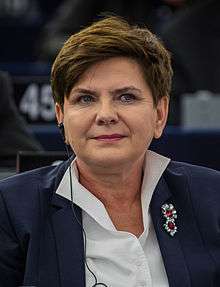Next Polish parliamentary election
| | |||||||||||||||||||||||||||||||||||||||||||||||||||||||||||||||||||||||||||
| |||||||||||||||||||||||||||||||||||||||||||||||||||||||||||||||||||||||||||
| |||||||||||||||||||||||||||||||||||||||||||||||||||||||||||||||||||||||||||
| |||||||||||||||||||||||||||||||||||||||||||||||||||||||||||||||||||||||||||
The next Polish parliamentary elections must be held not later than November 2019. All 460 members of the Sejm and 100 senators will be elected.
Background
Following the 2015 parliamentary elections the Law and Justice (PiS) party was able form a majority government, after receiving 235 seats to the 138 won by their main competitor, Civic Platform, the first time in the post-communist era that a party had won an outright majority in parliamentary elections.[1][2] Beata Szydło became Prime Minister on 16 November 2015, and despite winning a majority of seats, also included Solidary Poland and Poland Together in her cabinet.
On 23 December 2015 the Sejm passed a law, which reorganized the Constitutional Court, introducing a requirement for a two-thirds majority and the mandatory participation of at least 13, instead of 9 of the 15 judges. Article 190 (5) of the Polish Constitution requires only the majority of votes also in early 2016 PiS' government passed a law starting the process of giving the government full control of state radio and television.[3] After that, the Committee for the Defence of Democracy, with help from the Modern party, started mass demonstrations across the country.[4]
Electoral system
The 460 members of the Sejm are elected by open party-list proportional representation in multi-member constituencies. Seats are allocated using the D'hondt method, with a 5% threshold for single parties and 8% threshold for coalitions (although requirements waived for national minorities). The Senate is elected using first-past-the-post voting in single-member districts.[5] Candidates for Deputies are nominated either by the electoral committees of the various political parties and or by individual voter committees.[6]
Overall, the Sejm includes 460 MPs. Should a party have 231 or more deputies in Parliament, it has an absolute majority and could thus govern autonomously, without a coalition partner. The constitution can be amended with a supermajority of two-thirds, or 307 deputies.
Election date
Constitution of Poland requires that the next election should take place on a non-working day, Sunday or national holiday, within the 30-day period before the expiry of the 4-year period beginning from the commencement of the current Sejm's and Senate's term of office.[7] Elections can be held earlier under certain conditions, for instance if the Sejm is dissolved or no government is created in time limited by the constitution.[8]
Since the current Sejm and Senate first sitting took place on 12 November 2015,[9] possible dates are Sundays 13 October, 20 October, 27 October, 3 November and 10 November 2019. The other possible but unlikely dates are public holidays 1 November (All Saints' Day) and 11 November (Independence Day) 2019. The date will be chosen by the President of Poland.
Opinion polls

References
- ↑ "Poland Ousts Government as Law & Justice Gains Historic Majority". Bloomberg. 25 October 2015. Retrieved 25 October 2015.
- ↑ "Poland elections: Conservatives secure decisive win". 25 October 2015. Retrieved 25 October 2015.
- ↑ "Poland's president signs media law despite EU concerns". Business Insider. Retrieved 2016-01-30.
- ↑ "Polish media laws: Nationwide protests are staged - BBC News". BBC News. Retrieved 2016-01-30.
- ↑ Álvarez-Rivera, Manuel (17 October 2015). "Election Resources on the Internet: Elections to the Polish Sejm, Part I". electionresources.org. Retrieved 25 October 2015.
- ↑ http://www.sejm.gov.pl/english/sejm/pos.htm
- ↑ Constitution of Poland, Article 98, p. 2.
- ↑ Constitution of Poland, Article 98, p. 5.
- ↑ "12 listopada odbędą się pierwsze posiedzenia Sejmu i Senatu nowych kadencji". TVP. 5 November 2015. Retrieved 5 November 2015.

.jpg)